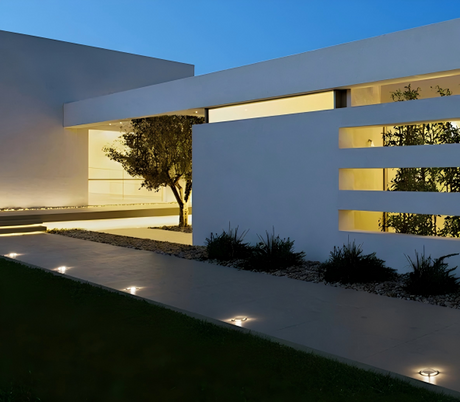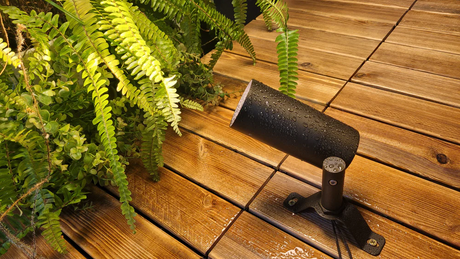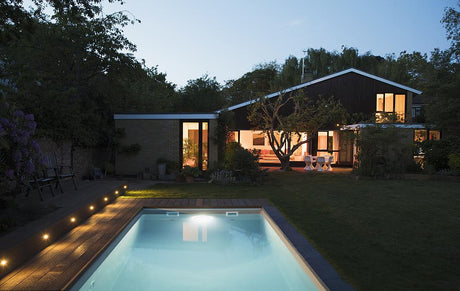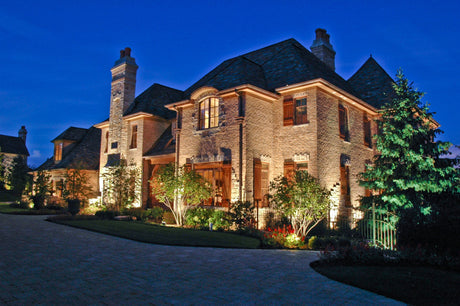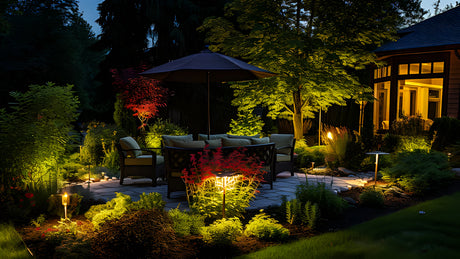Table of Contents
Introduction
The transformation of your outdoor living space doesn't end when the sun goes down. Properly designed outdoor lighting extends the functionality, beauty, and safety of your garden, patio, or pathway well into the evening hours. Among the various lighting options available, LED recessed lights have emerged as a premier choice for homeowners and landscape designers seeking seamless, effective, and efficient illumination.
These fixtures are designed to be discreetly embedded into surfaces, providing essential light without disrupting the visual harmony of your landscape. However, selecting the right fixtures involves more than just picking a style you like. It requires understanding landscape lighting principles, technical specifications, and installation nuances to create an inviting atmosphere while avoiding common pitfalls like light pollution, glare, and inadequate illumination.
This comprehensive guide will walk you through the critical considerations for choosing LED recessed lights for your outdoor living spaces, backed by technical data, expert insights, and practical advice to ensure your project's success.

Understanding LED Recessed Outdoor Lighting
LED recessed lights, often referred to as ground lights, well lights, or in-grade lights, are fixtures installed flush with the ground or a surface. They are engineered to handle significant weight and exposure to the elements while providing upward or directional lighting. Their primary applications in outdoor lighting include illuminating pathways, accentuating architectural features and trees, providing safety lighting for steps, and creating ambient mood lighting for entertainment areas.
The benefits of choosing LED technology for your landscape lighting are substantial:
- Energy Efficiency & Longevity: LED fixtures consume significantly less power than traditional halogen or incandescent bulbs. More importantly, they boast an impressive operational life, often rated at 50,000 hours or more. This translates to years of reliable service with minimal maintenance requirements.
- Durability & Reliability: Quality LED outdoor lighting fixtures are built to withstand harsh conditions. They are typically housed in robust materials like aluminum or stainless steel and are sealed to prevent moisture, dust, and debris ingress.
- Design Flexibility: Available in various sizes, beam angles, and color temperatures, LED recessed lights offer unparalleled flexibility to achieve specific lighting effects, from washing a wall with a wide flood of light to pinpointing a specimen tree with a narrow spotlight.
Key Technical Specifications Explained
Choosing the right LED recessed light requires careful attention to technical details. These specifications determine the fixture's performance, compatibility with your environment, and overall effectiveness.
IP (Ingress Protection) Rating
The IP rating is a non-negotiable starting point for any outdoor lighting fixture. It indicates the level of protection against solids and liquids.
- What it means: The first digit represents protection from solid objects (e.g., dust), and the second represents protection from liquids (moisture).
- Recommendation: For recessed fixtures installed in the ground, which are susceptible to water exposure from rain and irrigation, an IP67 or IP68 rating is essential 47. An IP67-rated light can withstand temporary immersion in water, while an IP68-rated light can handle prolonged immersion under specified pressure. This is critical for preventing short circuits and ensuring safety.
Color Temperature (CCT)
Color Temperature, measured in Kelvins (K), describes the apparent "warmth" or "coolness" of the light emitted.
- Warm White (2700K - 3000K): Creates a cozy, inviting, and traditional atmosphere. Ideal for residential gardens and patios. Experts often recommend warmer tones for landscape lighting; for instance, 3000K is a common warm white option 10, and some reports suggest even warmer tones below 3000K may be suitable for traditional communities.
- Natural White (4000K - 4500K): Provides a cleaner, more neutral light. Suitable for security lighting or highlighting modern architectural elements with crisp detail. The DOE has noted a trend towards 4000K for outdoor applications.
- Cool White (5000K - 6500K): Emits a bluish, daylight-like light. It can appear harsh in residential settings and is often better suited for commercial or task-oriented applications. While available, cooler temperatures should be used sparingly and thoughtfully in home landscapes.
Selecting the right CCT is crucial for setting the desired mood and enhancing the natural colors of your plants and hardscapes.

Lumens and Wattage
- Lumens measure the total amount of visible light emitted by a fixture (its brightness).
- Wattage measures the electrical power consumed.
With LEDs, higher wattage doesn't always mean brighter light; efficiency varies. Therefore, focus on lumens when comparing brightness.
- Brightness Guidelines: The required lumens depend on the application. For example, a pathway light might require 100-200 lumens, while an accent light for a large tree might need 500 lumens or more. Fixtures can range from smaller 3W models emitting around 330 lumens 4 to more powerful 18W fixtures offering 1800 lumens.
Beam Angle
The beam angle determines how the light is distributed from the fixture.
- Narrow Beam (15°-25°): Creates a focused spotlight effect, perfect for highlighting specific features like a statue, a tree trunk, or an architectural detail.
- Medium Beam (26°-45°): Offers a gentle wash of light, ideal for illuminating smaller trees and shrubs or providing area lighting.
- Wide Beam (46°-120° or more): Produces a broad, diffuse light, excellent for washing walls, lighting up wide pathways, or providing general ambient illumination.
Construction and Materials
The build quality directly impacts the fixture's durability and lifespan.
- Housing Material: Look for corrosion-resistant materials like die-cast aluminum or stainless steel (AISI 316L is premium grade) . These materials can withstand constant exposure to moisture and soil chemicals without degrading.
- Lens Material: Opt for tempered glass or high-borosilicate glass over plastic. Glass is far more resistant to yellowing, scratching, and hazing over time, maintaining light output and appearance. Polycarbonate or PMMA (acrylic) can be used but may be less durable under heavy foot traffic.
Designing Your Outdoor Lighting Plan
A successful landscape lighting scheme is layered, combining different techniques to create depth, interest, and functionality.
Lighting Techniques
- Moonlighting: This technique involves placing lights high up in trees and aiming them downward to simulate the soft, dappled effect of natural moonlight. It creates a wonderfully atmospheric and tranquil environment .
- Uplighting: This is a primary use for recessed well lights. By placing them at the base of a tree, wall, or other vertical feature, you can graze the surface to highlight texture or wash it with light to emphasize its form and presence.
- Path Lighting: While often associated with bollard or stake lights, recessed fixtures can be installed flush with pathway edging or steps to provide safe, low-level guidance without light pollution or glare.
- Silhouetting: Place a light behind a feature to create a dramatic silhouette against a wall or other surface.
Expert Layout Tips
- Less is More: Avoid over-lighting. The goal is to create pools of light that guide the eye and the foot, not to turn night into day. Over-lighting creates glare, light pollution, and a flat, uninteresting scene.
- Layer Your Light: Combine techniques. Use moonlighting for general ambient glow, uplighting for key features, and path lighting for safety.
- Consider Sight Lines: Design your layout from key viewpoints, such as from inside your home looking out or from your main patio area.
- Control and Flexibility: While not focusing on "smart" lights, consider adding simple controls like timers or dimmers to adjust the lighting for different occasions and save energy.
Professional landscape lighting designers often stress the importance of creating a balanced and subtle lighting scheme that enhances the beauty of the outdoor space without causing light pollution or glare.
Professional Installation Insights
Proper installation is just as critical as selecting the right fixture. Incorrect installation is a leading cause of premature fixture failure.
The Crucial Role of Precast Concrete Bases
Never install an in-ground light directly into soil or mulch. Always use a precast concrete base or a proprietary plastic housing. This practice:
- Provides Stability: Creates a solid foundation that prevents the fixture from shifting or tilting.
- Manages Water Drainage: The base should be set in a bed of gravel to facilitate drainage away from the fixture, preventing water from pooling around the electrical connections and housing, even with an IP68 rating.
- Protects Root Systems: For lights installed near trees, using a base minimizes disturbance to the root system during installation and future maintenance.

Waterproofing and Electrical Connections
The electrical connection is the most vulnerable point of any outdoor lighting system.
- Use Waterproof Connectors: Always use corrosion-resistant, waterproof wire connectors specifically designed for direct burial. These are typically filled with a silicone gel to block moisture.
- Consider a Centralized Transformer: Low-voltage systems (12V or 24V) are safer for DIY and are common in landscape lighting. Ensure your transformer is sized correctly for the total wattage of all your lights plus a 20% buffer.
- Professional Help: For high-voltage (120V) systems or if you are unsure at any point, always hire a licensed electrician. The risks associated with improper electrical installation are severe.
Avoiding Common Pitfalls
- Glare: Choose fixtures with built-in reflectors, baffles, or honeycomb louvers to control light cut-off and minimize glare, which is harsh to the eyes and detracts from the ambiance.
- Light Trespass: Angle your fixtures carefully to ensure light falls only on your intended property and does not spill onto neighboring homes or into the night sky.
- Thermal Management: LEDs generate heat, which must be managed to ensure longevity. Quality fixtures have heat sinks designed to dissipate heat effectively. Ensure fixtures are not covered by dirt, debris, or excessive mulch that can trap heat.
Conclusion
Investing in a well-designed LED recessed outdoor lighting system is a decision that pays dividends in beauty, functionality, and property value. It allows you to reclaim your outdoor spaces after dark, transforming them into enchanting extensions of your home. By focusing on the critical elements—robust IP ratings, appropriate color temperatures, thoughtful beam angles, and professional-grade installation techniques—you can create a stunning and durable landscape lighting scheme.
Move beyond merely illuminating darkness. Use light as a paintbrush to highlight the best features of your landscape, create mood and atmosphere, and enhance the security of your property. Start by mapping out your key areas, choose quality fixtures from reputable manufacturers, and don't hesitate to consult with or hire a professional landscape lighting designer for complex projects. Your perfect outdoor living space, day and night, is within reach.


